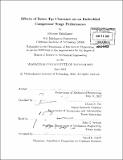| dc.contributor.advisor | Choon S. Tan. | en_US |
| dc.contributor.author | Sakulkaew, Sitanun | en_US |
| dc.contributor.other | Massachusetts Institute of Technology. Dept. of Mechanical Engineering. | en_US |
| dc.date.accessioned | 2012-11-19T19:32:43Z | |
| dc.date.available | 2012-11-19T19:32:43Z | |
| dc.date.copyright | 2012 | en_US |
| dc.date.issued | 2012 | en_US |
| dc.identifier.uri | http://hdl.handle.net/1721.1/74989 | |
| dc.description | Thesis (S.M.)--Massachusetts Institute of Technology, Dept. of Mechanical Engineering, 2012. | en_US |
| dc.description | Cataloged from PDF version of thesis. | en_US |
| dc.description | Includes bibliographical references (p. 111-114). | en_US |
| dc.description.abstract | Compressor efficiency variation with rotor tip gap is assessed using numerical simulations on an embedded stage representative of that in a large industrial gas turbine with Reynolds number being approximately 2 x 106 to 7 x 106. The results reveal three distinct behaviors of efficiency variation with tip gap. For relatively small tip gap (less than 0.8% span), the change in efficiency with tip gap is non-monotonic with an optimum tip gap for maximum efficiency. The optimum tip gap is set by two competing flow processes: decreasing tip leakage mixing loss and increasing viscous shear loss at the casing with decreasing tip gap. An optimum tip gap scaling is established and shown to satisfactorily quantify the optimal gap value. For medium tip gap (0.8% - 3.4% span), the efficiency decreases approximately on a linear basis with increasing tip clearance. However, for tip gap beyond a threshold value (3.4% span for this rotor), the efficiency becomes less sensitive to tip gap as the blade tip becomes more aft-loaded thus reducing tip flow mixing loss in the rotor passage. The threshold value is set by the competing effects between increasing tip leakage flow and decreasing tip flow induced mixing loss with increasing tip gap. Thus, to desensitize compressor performance variation with blade gap, rotor should be tip aft-loaded and hub fore-loaded while stator should be tip fore-loaded and hub aft-loaded as much as feasible. This reduces the opportunity for clearance flow mixing loss and maximizes the benefits of reversible work from unsteady effects in attenuating the clearance flow through the downstream blade-row. The net effect can be an overall compressor performance enhancement in terms of efficiency, pressure rise capability, robustness to end gap variation and potentially useful operable range broadening. Preliminary assessment of a stage redesign with a 4% chord more tip aft-loaded blade design for 1.7 % span tip clearance yields 0.2 point stage efficiency benefit. | en_US |
| dc.description.statementofresponsibility | by Sitanun Sakulkaew. | en_US |
| dc.format.extent | 114 p. | en_US |
| dc.language.iso | eng | en_US |
| dc.publisher | Massachusetts Institute of Technology | en_US |
| dc.rights | M.I.T. theses are protected by
copyright. They may be viewed from this source for any purpose, but
reproduction or distribution in any format is prohibited without written
permission. See provided URL for inquiries about permission. | en_US |
| dc.rights.uri | http://dspace.mit.edu/handle/1721.1/7582 | en_US |
| dc.subject | Mechanical Engineering. | en_US |
| dc.title | Effects of rotor tip clearance on an embedded compressor stage performance | en_US |
| dc.type | Thesis | en_US |
| dc.description.degree | S.M. | en_US |
| dc.contributor.department | Massachusetts Institute of Technology. Department of Mechanical Engineering | |
| dc.identifier.oclc | 815966448 | en_US |
